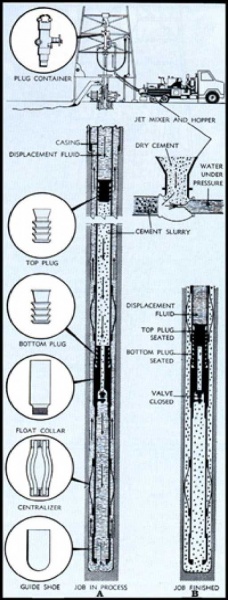Cementing well
CEMENTING PROCEDURE
Preparing the Hole
> Preparation of the hole for the cementing jobs starts long before the cementing operation itself.
> Before lowering the casing, usually drill pipes have been out of the hole a matter of 12 to 24 hours while surveys and other information were being obtained prior to the decision to set the casing, for example caliper survey of the hole size are run to know the exact dimension of the hole.
> Before pumping the slurry, mud circulation appears necessary to clean the hole and to remove cuttings and mud cake attached to the walls.
> At the same time the casing is worked up or down or rotated during mud circulation.
> Sometimes, immediately before putting cement, water added with 5% hexametaphosphate is pumped down the casing to disintegrate the mud cake.
Injection Of Slurry
> Most bore holes are filled with drilling fluid when the cementing operation begins and for this reason drilling mud is normally used as the displacing fluid.
> After the introduction of, the bottom plug, as the cement is pumped inside the casing the pumping pressure steadily decreases.
> When the bottom plug reaches the float collar (joint) pressure slightly increases then drop to indicate the rupture of the top plug.
> Then, the circulation pressure steadily increases indicating an increasing amount of slurry outside the casing. The arrival of the top plug on the bottom plug results in a sharp increase of the pump pressure.
> During the cementing operation, the return mud will flow back into the mud tanks.
> The returning mud should be watched carefully.
> If mud returns are not obtained at the surface while the cement is being pumped into the casing, then some fluid, either cement or mud is being lost in the formations.
> When this occurs, there is always some doubt about the proper placement of cement.
Considerations After Cementing
> After cement hardens, release the pressure on the casing permits it to contract so that the bond with the cement may be loosened. Release of pressure on the casing before the cement sets eliminates this problem. Bleed off the pressure is made if the the back pressure valve in the casing is holding satisfactorily.
> The usual waiting on cement (WOC) before drilling starts is about 12 hours for intermediate casing and 5 to 8 hours for surface casing counted from the moment the top plug reaches the float collar seat.
> WOC is required in order that the cement: anchors the pipe and withstands the shocks of subsequent operations; seals the permeable zones for prevention of the fluid movements behind the casing.
> The WOC usually employed permits a compressive strength of 500 psi to develop.
> Roughly WOC is equal to three times the thickening time under hole conditions.
> Temperature surveys to determine the cement top behind the casing should be run 4 to 6 hours after mixing. In most areas casing is pressure tested after the casing head and blowout preventers have been installed.
> The general practice is to exert 1500 psi with the rig pumps and hold this pressure for 30 minutes a pressure drop of 50psi/min is considered satisfactory.
> This technique is used for cementing two or more separate sections behind the casing string: when
> a long cement column could not be used without because if breakdown of the formation behind the casing,
> it is necessary to reduce the pump pressure at the surface, especially in cementing deep wells, and
> slurries of different compositions are used for cementing distinct sections.
> Multi stage cementing devices are used for stage cementing operations which when properly placed in the casing string will allow cement to be placed at the desired locations.
> Cementing of the lower section of casing is done first in the usual manner using plugs that will pass through the multistage collar without opening the ports of the collar.
> Special plugs can open the multi stage collar hydraulically and slurry is then circulated through the tool to the annular space.
> A special cementing basket attached to the outside of the casing to prevent the slurry from flowing down by gravity and directs it towards the surface.
> Squeeze cementing is a secondary cementing method in which relatively large pressures are used to force cement into places such as sealing off zones of lost.
Laws of Cementing Calculations Thickening Time
> Thickening Time T.T. = Mixing and Pumping Time + Displacement Time + Plug Release Time + Safety Factor
> Mixing and Pumping Time
> Mixing and Pumping Time = Volume of Cement Slurry / Mixing Rate
> Displacement Time = Displacement Volume / displacement rate
> Safety Factor = 30 — 60 min. normally used
> Notes
• Sp. Gr. of cement = 3.14
• Sp. Gr. of bentonite = 2.65
• Sp. Gr. of brite = 4.25
• Sp. Gr. of pozzolan = 2.5
• Sp. Gr. of perlite = 2.2
• Sp. Gr. of gilsonite = 1.07
 > Surface Time is the time required for the cement slurry to be prepared at the surface and retained for testing. This time is namely small and can be included as part of the mixing time.
> Surface Time is the time required for the cement slurry to be prepared at the surface and retained for testing. This time is namely small and can be included as part of the mixing time.
> Displacement Time: during mixing the cement slurry is pumped inside the casing until the entire dry volume of cement is mixed. This time is dependent on casing capacity and the displacement rate
> Number of sacks = Slurry volume / Slurry Yield
> Weight of cement = Volume x density
> Number of sacks of bentonite = amount of bentonite / 94
> Volume of mix water = No. of Sacks x water required per sack
